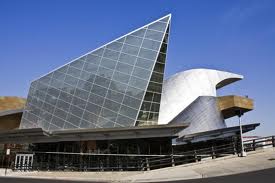The Taubman Museum of Art saga continues, with implications for art museums beyond big cities. The other day, at a meeting of about 300 museum supporters, director David Mickenberg presented a survival plan for the Roanoke, Va. facility, which opened in late 2008, and hit troubles almost immediately. Big ambitions — too big — were part of the problem.
 You can catch up on the background from my earlier post.
You can catch up on the background from my earlier post.
According to the Roanoke Times, artist John Wiercioch, “whose resume includes working for art museums,” said after the meeting that Mickenberg’s plan laid the groundwork for the community to embrace the Taubman as it adapts to the region it’s a part of. “This isn’t a New England-Eastern Seaboard population that’s used to going to museums.” The Taubman is making the right move by working out how to connect to a Southwest Virginia audience, he said.
Emphasis mine.
So, it seems, the Taubman (above) is redefining itself. On its website, the museum outlines the new direction: It will become an “arts center” — which “encompasses the functions of an art museum but is broader in scope and more of a hybrid non-profit, permanent cultural institution.” At the meeting, Mickenberg talked about commmunity support and fundraising, and the Times reported that Mickenberg said that the museum will “live or die” by its community support.
When the Taubman opened, it wasn’t thinking much about community support, and its “consultants” — whom Mickenberg declined to identify — overestimated its potential. In 2004, they predicted annual revenues of $745,000 in admissions, $230,000 in space rentals and $650,000 in retail sales.
The museum has lowered expectations, and for 2010-11, the budget projects admissions of $119,455, space rentals of $81,415 and retail sales of $134,000.Â
That’s $1.6 million versus $334,879 — quite a comedown.Â
The rest of the museum’s $2.6 million budget has to come from somewhere, or — as the Times reported, from “Building membership from 2,800 to 7,000. Enlisting more than 100 corporate sponsors. Starting a grass-roots fundraising campaign and asking donors who gave to the building fund to open their wallets again.”
And these are lowered expectations. Just last summer, Mickenberg was talking about a $3 million annual budget.
On the upside, he has hired several adjunct curators — local artists — to make up for the staff cuts made, in four rounds, since the museum opened.
By changing the museum’s mission, and talking about it in different terms, Mickenberg — and presumably the board — are trying to return to reality. And that’s a good thing. I don’t know Roanoke, but I tend to believe Wiercioch. As I’ve said before, not every community can support a high-faluting art museum. But that doesn’t mean everyone shouldn’t have access to art — quite the contrary. Is this the answer? It may be one answer, and I’m not sure that the Taubman can pull this one off.
Here’s the link to the Times article.
